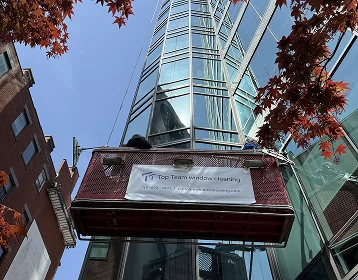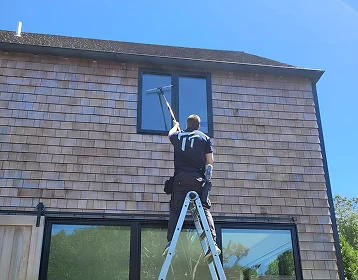When summer settles over New York City, commercial buildings experience a sharp increase in energy use. Air conditioning systems work harder and longer, while tenants, guests, and customers expect consistent comfort regardless of the heat outside. In this seasonal push for efficiency, most of the focus tends to fall on HVAC systems, insulation, and window tinting. However, one element is often left out of the conversation: the clarity and cleanliness of the windows.
Glass that is covered in dust, grime, or residue can interfere with the way a building interacts with natural light and heat. Instead of reflecting or filtering sunlight efficiently, dirty windows can trap heat, alter indoor temperatures, and place added strain on cooling equipment. Over time, this leads to unnecessary energy waste and higher electricity bills during peak summer months.
Keeping windows clean during the warmer season is about maintaining a neat appearance and also it is about a simple, practical way to support better building performance. In a dense urban environment like New York, where sunlight competes with airborne pollutants, construction dust, and high humidity, regular exterior cleaning becomes more than a matter of aesthetics. It becomes part of a responsible approach to property management.
This article will explore how clean glass contributes to energy savings in summer, what building managers and owners can do to improve efficiency through proper maintenance, and why even a small change in window care can have a measurable impact.
When glass stops working like glass
In a well-designed building, windows are active components of the structure’s energy system. High-quality glazing, double-pane units, and solar-reflective coatings all play a role in regulating interior temperatures, especially during the summer. These systems are engineered with the assumption that the glass surface remains clean. Once dust, pollutants, or mineral residues build up, that assumption stops holding true.
Even a thin film of dirt can interfere with how light interacts with the surface. Instead of being reflected or filtered, more sunlight is absorbed, especially in areas where the coating is obscured. This absorbed energy is converted into heat, which radiates inward and raises the ambient temperature of the room. For commercial buildings with wide curtain walls or floor-to-ceiling windows, this effect scales quickly and can increase cooling demands across multiple zones.
Specialized glass treatments like low-emissivity coatings or spectrally selective tints are designed to perform very specific optical tasks. They reduce unwanted solar gain while allowing visible light through. However, when grime masks the glass, these functions become less effective. Over time, the building’s overall thermal performance suffers, and HVAC systems are forced to work harder to compensate.
Routine professional window cleaning restores the intended performance of glazing systems. It ensures that energy-saving technologies are not compromised by surface buildup and that light, heat, and visibility are all managed the way the building’s designers planned. For property owners, this is about protecting the return on investment in energy-efficient infrastructure and maintaining consistent indoor conditions during peak cooling months.
When cooling never catches up
When windows lose their clarity, the interior environment shifts in subtle, but significant ways. What begins as a slight haze can grow into a system-wide inefficiency. In sunlit areas, thermal buildup intensifies not because of faulty infrastructure, but because the building envelope no longer behaves as expected. The glass still transmits light, but with more absorbed heat and less control over solar gain.
In buildings that rely on expansive glazing for daylighting, this can affect multiple zones at once. Temperature sensors react to rising internal heat, prompting cooling systems to compensate. Over time, this reactive cycle consumes more energy, reduces overall system efficiency, and places uneven strain on HVAC components, particularly in areas exposed to prolonged sun.
Improving window clarity and surface reflectance offers measurable energy benefits. In commercial spaces, that can translate to a 5–10% reduction in summer cooling loads, depending on climate, glass type, and building orientation. For owners focused on energy benchmarks or building performance ratings, this is a detail with outsized impact.
Professional maintenance restores the appearance of the building and also the balance of its internal systems. By managing heat before it enters the envelope, clean windows support consistent cooling, stable zones, and lower mechanical stress, especially during peak demand periods.
Seasonal cleaning as part of building health
In the summer glass surfaces face an increased load of heat, pollution, and biological residue. Pollen, mineral deposits from evaporated rain, and airborne particles settle faster when the weather is hot and dry. As this residue accumulates, it affects how a building looks and how its envelope performs under environmental stress. Windows that are neglected during these months begin to show signs of permanent damage much sooner, including etching, hazing, and corrosion around the seals.
Routine summer cleaning helps maintain the integrity of both the glass and its framing systems. If dirt is left to bake into the surface under the sun, it becomes more difficult to remove without abrasion. This kind of build-up shortens the service life of modern coatings, reduces the effectiveness of thermal films, and in some cases, can affect the airtightness of the installation.
For building managers focused on long-term cost control, seasonal maintenance is a practical decision. Clean windows support better solar control, help prevent HVAC overuse, and preserve the investment made in glazing and façade technology. When these actions are part of a planned approach, the result is a better-performing building envelope and fewer unplanned expenses.
There is also a growing interest in making window maintenance part of a broader sustainability strategy. By improving energy efficiency and reducing the need for premature material replacement, regular cleaning aligns with both LEED principles and Local Law 97 benchmarks. At Top Team window cleaning, we prioritize environmentally responsible methods that minimize water usage, avoid harsh chemicals, and support the long-term health of urban buildings.
Why professional methods make a measurable difference
When it comes to keeping windows clean during the summer, the temptation to rely on in-house staff or quick DIY methods is understandable. However, these approaches often fall short, especially in commercial buildings where access, safety, and long-term material care require specialized knowledge and equipment. Many of the most common signs of wear, permanent streaking, film damage, or discoloration around the frames, begin with well-intentioned, but improper cleaning practices.
Professional window cleaning teams are trained to work safely and effectively on buildings of all sizes. They have the tools to reach upper floors without compromising safety or relying on interior access. Water-fed pole systems, lift equipment, and rope access solutions make it possible to clean even the most complex facades without exposing workers or pedestrians to unnecessary risk.
Beyond access, the difference lies in the materials and methods used. Commercial-grade cleaners leave no film or residue, even in high sun and humidity. Soft-bristle brushes and deionized water help protect delicate coatings, including UV films and energy-efficient glazing. For facades that require broader attention, such as those affected by biological staining, heavy deposits, or sidewalk-level grime, pressure washing services provide a safe and controlled solution, tailored to surface type and environmental condition.
While simple surface cleaning might restore short-term visibility, it often overlooks the underlying buildup that affects long-term performance. Dust, airborne pollutants, and mineral deposits gradually etch into the glass, reducing transparency and weakening coatings designed to reflect solar heat. Professional window cleaning addresses these issues by fully removing contaminants before they can take hold, preserving both function and appearance.
A comprehensive cleaning service goes beyond the glass itself. It includes careful attention to window frames, sills, and drainage paths, which are often neglected in quick wipe-downs. Removing debris from these areas helps prevent moisture buildup, frame corrosion, and the growth of mold or mildew, all of which can affect air quality and thermal efficiency. Consistent maintenance can also extend the lifespan of seals and insulation layers, which play a critical role in keeping conditioned air inside and summer heat out.
Cleaning strategies that match the season and the structure
Each building in New York faces a unique combination of sun exposure, street-level activity, and weather-related stress. A glass storefront in Midtown experiences different demands than a shaded office facade in the Financial District or a recently completed residential tower in Brooklyn. This is why a one-size-fits-all approach to window maintenance rarely delivers consistent results. At Top Team window cleaning, we design custom cleaning plans that consider the building’s layout, materials, and also how the summer season intensifies both visibility issues and thermal impact.
Sun-facing surfaces accumulate grime more quickly and windows near active roadways pick up more airborne particles, especially during construction-heavy months. Materials like treated aluminum, specialty coatings, or composite panels can be affected differently depending on how heat and pollutants interact with them. We factor in all of these variables when planning cleaning schedules, ensuring that work is carried out at the right frequency and with the right method for the structure.
In addition to routine maintenance, summer is an important time to address any lingering effects of recent construction work. Dust, adhesives, and sealant residue can impair the performance of insulated glazing units or interfere with solar control films. Our post-construction cleaning removes these materials safely and without damaging new finishes, helping properties transition smoothly from completion to occupancy. A tailored plan ensures that cleaning supports the building’s operational goals, aligns with tenant schedules, and minimizes strain on cooling systems at the hottest point of the year.
If your property requires special consideration due to its orientation, recent renovations, or façade materials, we can assess and recommend a seasonal program that fits both your technical and aesthetic needs.
A clean finish that pays off twice
Clean glass helps maintain a professional exterior, supports your sustainability goals, and improves the way a building performs during peak-season conditions. When sunlight passes through a surface that’s clear and properly maintained, interior temperatures remain more stable and energy usage becomes easier to manage.
A seasonal cleaning program is not simply about looking prepared for visitors or clients. It is also about protecting the integrity of building systems and reducing long-term wear on glazing materials. Small steps taken regularly, such as removing residue or scheduling preventive washes, have a measurable effect on energy efficiency. They also reduce the risk of surface damage that tends to appear when dirt and heat are allowed to accumulate over time.
At Top Team window cleaning, we help commercial properties make informed choices about building maintenance. If you are considering ways to reduce energy use or planning upgrades for warmer months, we offer a complimentary on-site window condition check. It focuses on visibility, material wear, and energy performance factors that can be improved with targeted cleaning.
Reach out to us at 718-673-7893 or info@topteamwindowcleaning.com to schedule your summer assessment and see how clean windows can support how your building works.



